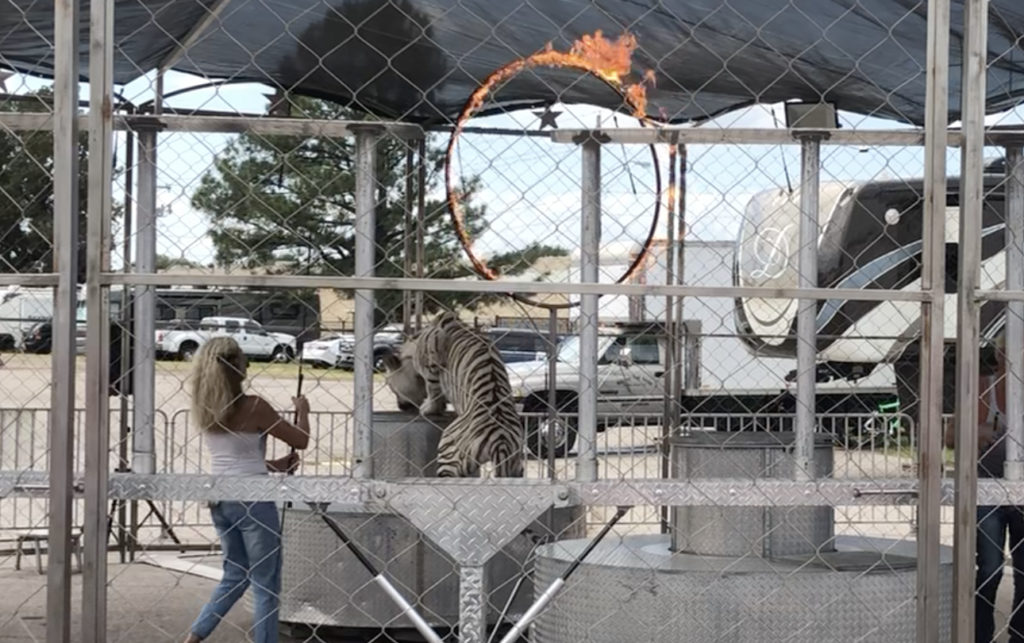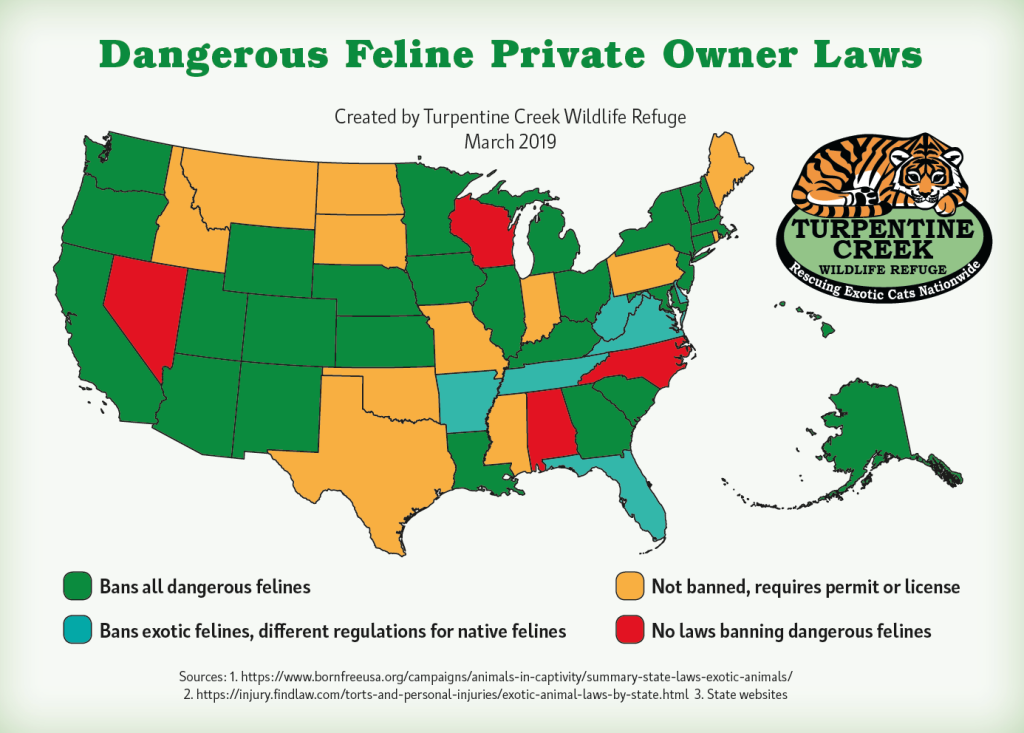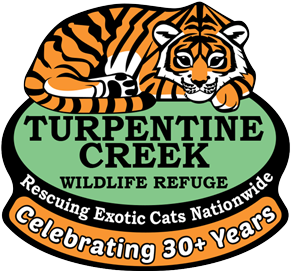Latest BCPSA Update
The bill has been signed into law by President Biden!
Why is the Big Cat Public Safety Act important?

Preventing Neglect and Abuse
Today there are more tigers living in the United States than in the wild. With no official registry, we can only guess at the number of tigers and other big cats in the U.S., but based on the information we do have access to, estimates for captive tigers in the U.S. range from 7,000 – 10,000. When adding other species of big cats living in captivity this number could more than double. Very few live in AZA-accredited zoos and true sanctuaries. The rest are part of backyard breeders, roadside zoos, and are privately owned.
What is the BCPSA?

Currently, regulation of private ownership and handling of big cats are made by each state.
- 23 states have a complete ban on private ownership.
- 13 states have a partial ban on private ownership.
- 10 states only require licenses to own dangerous exotic animals.
- 4 states have NO regulations on private ownership.
The proposed federal bill, Big Cat Public Safety Act, will make it illegal to buy, sell, trade, transport across state lines without permits, privately own, or allow the public to have hands-on interaction with prohibited types of big cats.
Issues Captive Big Cats Face
Overbreeding
- Demand for cubs is high in the cub petting pay-to-play industry. Cubs can only be legally handled between the ages of 1-month and 3-months old. To keep a steady supply of cubs, big cats must be continuously bred. Cub petting schemes can make between $7,000 – $9,000+ per day, so keeping cubs small is the best way to profit. What happens to these cubs after they age-out of pay-to-play?
- Cubs are often removed from their mothers immediately after birth. This means that cubs do not get vital nutrients and natural antibodies from their mother’s milk. What happens if a cub doesn’t have a strong immune system and is around sick animals or people?
- When cubs are removed, it sends the mother back into estrus so she can get pregnant again. In the wild, big cats only have cubs once every 2-3 years. Breeding so frequently, they do not have the time to replenish the depleted nutrients and energy that it took to create 2-4 little lives. Eventually, the mother’s body is so exhausted from breeding that they get infections or die prematurely. What happens to big cats that can no longer produce healthy cubs?
- Unregulated breeding facilities do not track family relations. They often trade cats with other facilities to get a “fresh” genetic crop, but without knowing the parents of those cats how do they know that the cats are not related? They don’t. Sometimes the breeders do not care. White tigers are more valuable, but since the white gene is recessive the most assured way to get a white cub is to either breed 2 white tigers or 1 white tiger and 1 orange tiger with a white parent. All white tigers are related, so most breeders don’t care if they breed parents to children or siblings as long as it produces white cubs. What happens to the non-white cubs that are born, or the cubs born with deformities?
- The genetics of many white tigers are riddled with inbreeding. Unregulated breeding means that many breeders don’t care if their cat is a little “off.” They continue to breed cats despite their health issues. Tigers are born with deformed bones, crooked spines, crossed eyes, undersized, oversized, hearing issues, etc., etc., and yet breeders keep them in the genetic pool. These cubs would never survive in the wild, and if they were ever introduced into the genetic pool of the wild population, they would decimate the population, killing it off completely. What would happen to a deformed cub in the wild?
Safety
- Since 1990, there have been at least 365 reported dangerous incidents involving big cats. At least 19 adults and 4 children have been killed, 230 people mauled, and 240 big cat escapes in the U.S. alone. In Oct. 2011, a private owner in Zanesville, OH, released 56 dangerous exotic big cats after destroying the fencing so they could not be recaptured, 51 animals were killed to protect the public. Do you know what to do if a big cat escapes?
- Big cats have big teeth and big claws. A full-grown tiger’s canine can be up to 3 inches long! Handling of even young cubs can result in injuries. Many individuals and facilities that allow hands-on interaction with big cats will declaw them and remove their canine teeth to make them “safer,” but this is detrimental to the health and well-being of the animals. Is it worth serious injury to yourself or your child, and lifelong pain for the animal, just to pet a big cat for 10 minutes?
Abuse & Neglect
- Many big cat trainers have been documented using punishment to control big cats. If a cat does not obey a command or acts aggressively, they are punished. Punishment might work temporarily but many times it does not change the animal’s natural instincts. It can cause animals to be more aggressive. What happens when the trainer drops their guard?
- Forcing cubs to stay awake when they should be sleeping is abuse – it causes exhaustion and stress. When a cub is stressed it can weaken an already low immune system and the cub can easily get sick. Some illnesses can be transmitted between cats and humans. What happens to a sick cub when it can no longer be used to make money?
- Inhumane euthanasia is a commonly cited violation in many USDA reports. Animals strangled, beaten with blunt objects, repeatedly shot, starved to death, denied proper veterinary care, and various other inhumane reported deaths happen every year to captive big cats in the U.S. If people are convicted for mistreatment of dogs, why is it okay to do the same thing to big cats?
- Many big cats spend their lives in unclean cages. They live in small cages filled with their own waste, rotting food, animal carcasses, and filthy water. This causes diseases, infection, and suffering for the animals. Would you want to drink water contaminated with rotting meat, urine, feces, and bacteria?
Improper Nutrition
- Big cats require specific nutrients to be healthy. Taurine is just one of the many nutrients required for big cats. Many breeders will tell new owners that if they don’t feed raw meat to the cats they will be “tame.” This is not true, big cats cannot get their required nutrients from cooked meat, so even though the cat is eating, it is slowly starving to death. Why would someone lie about nutritional needs?
- Some breeders tell people to keep their cats ‘”fat and happy” and purposely overfeed their cats to keep them from attacking them. This causes the animals to be morbidly obese and have health issues. Does being “fat and happy” truly prevent injury or just cause unnecessary suffering?
- Cubs need a lot of calcium. If they do not get the right amounts of calcium they can develop Metabolic Bone Disease. Cats with Metabolic Bone Disease have brittle and misshapen bones. This will cause a lifetime of pain and suffering for the cat if not properly treated. There is no cure for Metabolic Bone Disease, it can only be managed. How can an individual keep track of how much a cub is eating when they are constantly passed around?
- It costs approximately $10,000 a year to feed and care for a big cat. What happens if the funding runs out?
Lack of Options
- When a private owner gets sick, dies, loses their job, funding, home, is too old to care for their big cat, or is injured there are few options to rehome them. What happens to an animal when no options are available?
- Many good sanctuaries are currently full or don’t have the funding to take on any more animals.
- Very few AZA zoos take in rescues.
- Shelters are not equipped for big cats.
- Friends/Family might not be able to or want to care for the big cat.
- If an animal escapes, authorities will shoot to kill, not to tranquilize. Tranquilization takes time and with dangerous animals, like big cats, the longer the animal is loose, the more people are in danger. Police are not trained to deal with big cat escapes, are you?
- When a natural disaster occurs, there are no places for these animals to be safely housed to ride out the storm. What happens if their enclosure is damaged or their owners have to evacuate?
How The Big Cat Public Safety Act Helps
Ends Overbreeding
By putting an end to the pay-to-play cub-petting scheme and photo ops, the demand for cubs will drastically drop.
Prevents Injury
No hands-on interactions will reduce the number of injuries and escapes by big cats. With only trained professionals handling big cats under specific circumstances, there will be fewer opportunities for big cats to attack people and cause injuries.
Will Eventually End Private Ownership
Although current owners are grandfathered in, as long as they register their animals and follow the new rules, private purchasing of animals will end when the bill is passed. Within 20 – 25 years private ownership will no longer be an issue.
Exemptions
There will be exceptions to the Big Cat Public Safety Act. Qualified exemptions will be required to have a Class C license from the Department of Agriculture and be a qualifying zoo, sanctuary, state college, university, agency, or State-licensed veterinarian.
The Big Cat Public Safety Act will define and give guidelines for approved facilities –
- A facility that is exempt from taxation under 501(a) of the Internal Revenue Code of 1986 and described in sections 501(c)(3) and 170(b)(1)(A)(vi) of such Code.
- Does not breed the prohibited wildlife species unless they are part of a peer-reviewed species survival plan.
- Does not trade restricted species.
- Does not allow direct contact between the public and prohibited wildlife species.
- Does not allow the transport and display of prohibited wildlife species off-site.
Penalties
Violations of the Big Cat Public Safety Act are clearly defined in the bill. Individuals or entities that knowingly violate the act will:
- Be fined $20,000 and/or get a maximum of 5 years in jail.
- Each animal qualifies as a single violation. If multiple animals are involved, each animal will count as a separate offense.
